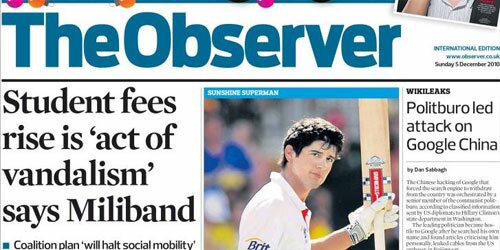Decoding the Tory cancer policy
4:00 pm - April 14th 2010
| Tweet | Share on Tumblr |
Healthcare provision NHS is, naturally enough, one of the more important battlegrounds on which the upcoming election is being fought – after the economy, of course.
Its area that has already thrown up its fair share of controversy, particular in regards to cancer services. Labour have been pilloried by the right-wing press over an unsubstantiated allegation that it specifically targeted some cancer sufferers with a leaflet attacking Tory plans to remove targets for providing access to cancer services, a media-generated furore that conveniently deflected attention away from a much more serious issue:
Only last week, the Tory’s putative Health Minister, Andrew Lansley, was torn off a strip by the Sir Andrew Dillon, the Chief Executive of the National Institute of Health and Clinical Excellence (NICE) for misleading patients over current policy on authorising new drug treatments for use by the NHS.
Unlike the cancer leaflets issue, this is no mere storm in a teacup but an issue that goes right to heart of the Tory’s manifesto plans and, in particular, to this statement from the Tory manifesto:
NHS patients rightly expect to be among the first in the world to access effective treatments, but under Labour they are among the last.
The key phrase here is ‘effective treatments’ – in fact it is precisely because the NHS (through NICE) is one of the few healthcare providers in the world that actually examines the evidence for the efficacy of new treatments, relative to existing treatments for the same condition/patient group, before approving them for use that we have to wait a little longer to access some new drugs than is typically the case in, for example, the United States.
Although the FDA does evaluate the effectiveness of new drugs, what it doesn’t do is assess their performance relative to the efficacy of existing treatments, an essential feature of the kind of cost-benefit analyses that form part of NICE’s evaluation protocols. That has a clear knock on effect on the work that NICE undertakes for the NHS. Because comparative studies aren’t required by the FDA in order to obtain a license in what is by far the largest and most important pharmaceuticals market in the world, the drug companies do not include their in the standard trial protocols. What NICE typically get to work with are hypothetical comparative models derived from combining trial data for the data for the new drug with data from separate trials of the current best available treatment. These models, which are initially provided by the drug manufacturers, are a constant source of dispute as, naturally enough, manufacturers are prone to cherry picking the data for their models to create the most favourable impression possible, all of which can easily lead to several weeks and even months of wrangling over the validity of these models, delaying the evaluation process as a whole.
This is the real choice that the two parties are offering cancer patients and it one that best illustrated with a case study of new drug, Dronedarone, which NICE is expected to approve for use by the NHS later this year.
Dronedarone, which is marketed under the brand name Multaq, is new drug treatment for atrial fibrillation, a common from of cardiac arrhythmia (irregular heartbeat), a condition for which there have been no significant advances in drug treatment for around 25 years.
Only 18 months ago, Dronedarone was being touted as the ‘next big thing’ for patients with atrial fibrillation and attracted glowing coverage in the Daily Telegraph, in a typically uncritical article which suggested that more than 300,000 patients in the UK could receive the drug, when it was licensed for use, and that it could prevent up to 10,000 stokes in that patient group every year.
In January this year, the drug hit the headlines again, on this occasion because an initial technical appraisal of the drug, which was licensed in the US in July 2008, recommended against approving it for use by the NHS. Inevitably, this was picked up by the media who ran the story in line with their usual narrative, under which NICE were accused of refusing the sanction of the use of the drug for bureaucratic reasons relating to its cost relative to existing treatments.
What’s much more interesting, and revealing, about these two stories, which were published only 16 month apart, it the very different estimate the later story gives for the number of patients who were thought likely to benefit from Dronedarone. From an initial 300,000+ cited in September 2008, this figure has now fallen to a mere 40,000, a drop of around 87%.
Clearly, something else was going on in the background – something that the Daily Express chose not to disclose to its readers.
What the Express didn’t mention
What has in fact happened was that, even before it was licensed, the trial results for Dronedarone had failed to live up to early expectations. In fact what the manufacturers own data showed was that, for the vast majority of patients with atrial fibrillation, Dronedarone was only half as effective as existing drug treatments for this condition, all of which are considerably cheaper because their patents expired several years ago, allowing them to be produced as generics.
As a result, although the drug was licensed by the FDA in July 2009 it was awarded only a restricted licence, one that limited it use to a specific subset of patients for the purpose of reducing the risk of heart-related hospitalisation where those patients also had one or more other significant cardiac risk factors such as diabetes, high blood pressure, a prior stroke or advanced age (i.e. over 70). This was, and still is, the only patient group for which there was clear evidence that the drug performs better than existing treatments.
Dronedarone is also required, in the US, to carry a ‘black label warning’ prohibiting its use with patients with two specific types of heart condition, both of which cause give rise to atrial fibrillation, after a trial that included patients with those conditions had to be stopped before it was completed because preliminary data showed that the drug doubled the mortality rate in those patients. That’s another minor detail that the Express chose not to mention.
This is precisely what NICE also found when it published its initial technical appraisal of Dronedarone in December 2009 and it explains why that appraisal came out against approving the drug for use in the NHS on the basis for which its initial application had been submitted. That is the other crucial omission from the Daily Express’s overheated article. Dronedarone was put forward for evaluation by NICE in November 2008, eight months before the drug was awarded it restricted license in the US and some four month before the FDA published its technical appraisal of the drug, in March 2009. Although the drug had been granted a limited license in the US in July 2009, a year after it was put forward for evaluation by the FDA, NICE were still in the position of having to evaluate Dronedarone as a potential treatment for patients that the FDA had already ruled out in the review, because that was what was on the application submitted by the drug’s manufacturer, Sanofi-Aventis.
After reviewing the technical appraisal and consulting with the manufacturer and range of other stakeholders (i.e. charities, patient support groups, etc.) NICE has now decided to recommend that Dronedarone should be approved for use by the NHS on broadly similar terms to that for which it is licensed in the US. This has been described by the Telegraph as a ‘U-turn’ – it isn’t. The post appraisal consultation that NICE undertook is a standard element in its review process and the higher cost of the drug, relative to existing drugs, was a fairly insignificant factor in the technical panels initial assessment – what actually matters was the fact that, for most patients, Dronedarone is less effective than existing treatments.
There is, however, one very important difference between NICE’s revised recommendation and the license terms set out by the FDA. Based on its evaluation of the research evidence NICE is proposing to approve the drug for use only as second-line treatment, i.e. one that will prescribed only to patients that meet the relevant criteria if existing treatment prove to ineffective or if the patient experiences any significant side-effect from those drugs.
(The FDA made no such recommendation)
This view is supported by a newly published review in the Journal of the American College of Cardiology which calls into question the value of the data quality and relevance to clinical practices from one of the key trials included in the evidence submitted to the FDA (and NICE) and cautions against the indiscriminate use of the drug in the face of efforts by its manufacturer to actively promote it for use ‘off-label’, i.e. outside the terms specified by the FDA license.
This is side to whole debate about patient access to new drugs that the public rarely sees, although if you are interested there’s a pretty good article here (may require registration) that does a fair job of explaining the controversy that this particular study has sparked off and the complexity of the issues it raises. Typically, disputes over the value of the evidence base for, and efficacy of, new drugs are played out well away from the public’s gaze on the pages of medical journals and other specialist publications. Only if something goes badly wrong, as happened with thalidomide, or if long-term follow-up studies emerge that raise significant questions about the effectiveness of particular drugs, as has happened relatively recently in the case of SSRI antidepressants (e.g. Prozac), does the public ever get wind of the kind of uncertainties and risks that remain in place, even after a new drug has been licensed for use.
For that reason, it’s actually very easy for the Tories to mislead the electorate by promising that cancer patients will receive faster access to ‘effective treatments’ even though what their policy actually amounts to is, for the most part, simply that of giving NHS doctors more scope to bypass the recommendations issued by NICE and prescribe new drugs off-label. That may give some cancer patients the drugs they want, but it in no sense offers them any guarantee that the treatment they get as a result will actually prove to be effective. Some may benefit, others may not – it’s even possible that some cancer patients may have their lives shortened or experience severe side-effects as a result of being prescribed new drugs either off off-label or under conditions in which their efficacy has not been adequately verified.
While the Tories may be able to promise faster access to new treatments, what they cannot legitimately promise is that those treatments will be effective, and that is the real debate that we should be having here, not to mention the challenge that Labour and other parties should be putting to them in response to this part of their manifesto.
| Tweet | Share on Tumblr |  |
'Unity' is a regular contributor to Liberal Conspiracy. He also blogs at Ministry of Truth.
· Other posts by Unity
Story Filed Under: Blog ,Conservative Party ,Health ,Science
Sorry, the comment form is closed at this time.
Reader comments
“The key phrase here is ‘effective treatments’ – in fact it is precisely because the NHS (through NICE) is one of the few healthcare providers in the world that actually examines the evidence for the efficacy of new treatments before approving them for use that we have to wait a little longer to access some new drugs than is typically the case in, for example, the United States.”
No. The FDA also examines the effectiveness of drugs.
What NICE also does, over and above what the FDA does, is look at the fiscal efficiency of a drug. “Too expensive” for the benefits and the NHS won’t pay for it.
The rest of what you’ve said is very interesting but doesn’t make clear that important distinction.
You’re right, Tim.
The FDA does assess effectiveness but does so in very different way to NICE, one that complicates matters.
That said, there’s more to this than just the cost element. NICE also routinely requires comparative data showing the performance of new treatments against the current best available, even if cost isn’t going to be a significant issue.
The FDA doesn’t – and because it regulates the biggest and most important market in the world, drug companies gear their trial protocols to their FDA’s requirements, which means that they often don’t have the data that NICE require.
From reading a few different NICE appraisals, one of the more time consuming aspects of its process seems to be the amount of time spent arguing with manufacturers over the validity and accuracy of their comparative evidence models.
Anyway, that’s another huge can of worms that’s too big to open at the moments, but I have updated to the post to try and better reflect how the FDA and NICE differ in approach.
“You’re right, Tim.”
Blogger accepts well meaning criticism in well meaning manner!
Quick, hide the women and children! Prepare to evacuate!
Blimey, what’s going on? Someone slipped happy pills into the water supply? An election going on or something?
Come on, Tim. I think we’ve both been around long enough to continue to observe the little niceties even with an election under way.
“I think we’ve both been around long enough to continue to observe the little niceties”
Apologies, clearly my reverse snark didn’t come through properly.
“Apologies”
Clearly, strong drugs in the water systems, see, it’s happened again!
Excellent piece unity. I would also point you to the story of the use of Lucentis and Avastin for treating “wet” age-related macular degeneration. (I cover the issue on my site, but Irv Irons blog has a lot of details about these drugs as used in the US.)
In short Avastin is a bowel cancer drug but was found to halt “wet” age-related macular degeneration. So the manufacturer altered the drug to remove the cancer active part and called it Lucentis. The two drugs have the same effect on “wet” age-related macular degeneration, but Avastin was only put forward for licensing for treating bowel cancer in the UK and Lucentis was put forward for licensing for treating “wet” age-related macular degeneration. The company decided to cost Lucentis according to how much the patient would pay to retain their sight. That is, £1000 per treatment, and (a local eye surgeon told me) about ten treatments are needed. Although Avastin is expensive as a bowel cancer drug (that’s another story) the volumes needed are so small that the cost for treating “wet” age-related macular degeneration is £1 per treatment.
NICE can only approve licensed drugs, so for “wet” age-related macular degeneration it can only approve Lucentis. They came to a deal with the manufacturers that the NHS would pay for the first 14 treatments and after that the manufacturer would provide the drug for free. But as I mentioned above, most people need just 10 treatments. The eye surgeon I spoke to said that in his clinic he offers patients the choice of having the licensed Lucentis or the unlicensed Avastin, pointing out that they are the same, but the former is a thousand times more expensive than the latter. Half of patients choose Avastin.
The Tories use the case of Lucentis (but not the details I have provided) as an example of the way that they want NICE to work. I think this affair is disgraceful and it does not show the Tories in good light either.
Dronedarone is an example of the ‘like me’ generation of newer drugs – it is a variation on amioderone.
Amioderone is a versatile drug than can be used to treat both ‘broad’ and ‘narrow-complex’ tachycardias, as well as being integral in certain cardiac arrest situations – it’s newer cousin (dronedarone) is licensed for atrial fibrillation AND atrial flutter.
Perhaps it is worth noting that the golden age of new chemical compounds has long since passed and the emergence of original drug therapies has dwindled in recent years – not even the money grubbing Andrew Lansley can change this particular trend.
http://www.thisislondon.co.uk/standard/article-23795736-shadow-ministers-pound-21000-gift-from-private-health-firm.do
Of course it is impossible to equate a coherent health policy with drugs alone – to my mind the NHS should be doing far more in the sphere of palliative care, for example.
Failings in this area of cancer care are long standing, and well documented yet are unlikely to be enhanced by a sexy new drug.
http://www.independent.co.uk/life-style/health-and-families/health-news/thousands-denied-dignified-end-by-postcode-lottery-for-palliative-care-554151.html
Incidentally most experienced medical staff would be cautious to use words like ‘guarantee’ when it comes to drug therapy.
Remember data is based on populations, not individual patients – so a drug may favour a given population but this is not the same thing as it favouring YOU.
I see that the NNT (numbers needed to treat) for dronedarone is 13
http://www.npci.org.uk/blog/?p=289
Perhaps Tim Worstall [1] can tell us if it’s worth paying for?
This is a really good article – shame it had to be that long because then obviously less people read it. But it’s a good indictment of Tory policy in a way I haven’t read anywhere else.
Mind you, if it had got more readers no doubt some of them would have accused you of being insensitive to cancer patients etc etc.
@pickledpolitics
Decoding the Tory’s cancer policy
Is there only one Tory?
Cameron’s riff on cancer drugs (being denied to NHS patients by NuLab) played out in all it’s glory last night – this portrayal was almost on a par with Hannan’s recent sojourn to the heartlands of the American right.
Is there no new depth that some of these characters will sink to?
Unity,
My UK friend, I think it’s important to note–which one of the links did, but the blog didn’t–that in the companion commentary to the Cedar Sinai study, atrial fibrillation experts believe Multaq should be a first-line treatment due to data indicating its greater safety. The study itself insists it is no safer, yet NICE agrees that it is.
Based on that information, and without even having to lie, it’s easy to make a case for the jury still being rather “out” on this medication and to opine that, if indeed cost is no issue (I’m an American, but NICE is the UK’s “cost-effectiveness” watchdog, no?) safety should come first–yet NICE decided to stick with generics. Hmm.
Also, if readers are concerned about black label warnings, they might do well to read the side effects of most birth control pills, since most can contribute to higher blood pressure, blood clots, and stroke, and women who take them (particularly those who are over 35) are discouraged from so much as having a fag, since smoking increases these risks.
Lastly, as an American, please let me praise the famous British civility with which you & your contributors have graciously decorated your board. I doubt a US blog on this topic would contain much of that for long …
I wish all of you very well ![]()
I’d should test with you here. Which is not something I normally do! I take pleasure in reading a submit that will make individuals think. Also, thanks for allowing me to comment!
Reactions: Twitter, blogs
-
Unity
RT @libcon: Decoding the Tory's cancer policy http://bit.ly/bTbAiJ
-
House Of Twits
RT @libcon Decoding the Tory's cancer policy http://bit.ly/bTbAiJ
-
Sunil
Liberal Conspiracy » Decoding the Tory's cancer policy http://bit.ly/9DLgFQ
-
andrew
Liberal Conspiracy » Decoding the Tory's cancer policy: Liberal Conspiracy » Decoding the Tory's cancer policy htt… http://bit.ly/cZB9yd
-
Liberal Conspiracy
Decoding the Tory's cancer policy http://bit.ly/bTbAiJ
-
sunny hundal
Really good article by @unity_mot explaining why Tory policy on cancer treatment is disingenuous http://bit.ly/chi2FT
-
Natalie Catchpole
Why the dishonest Tory cancer policy is worse than useless: https://liberalconspiracy.org/2010/04/14/decoding-the-torys-cancer-policy/
Sorry, the comment form is closed at this time.
NEWS ARTICLES ARCHIVE





















